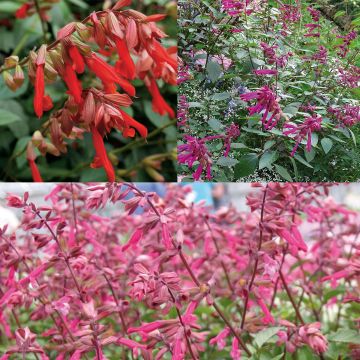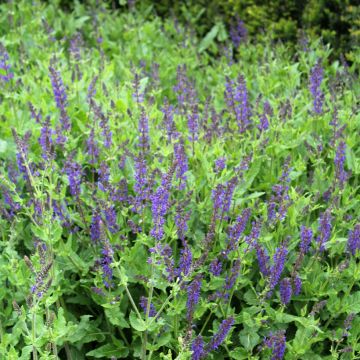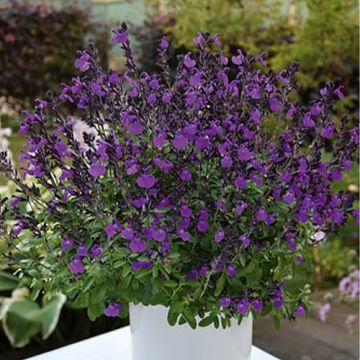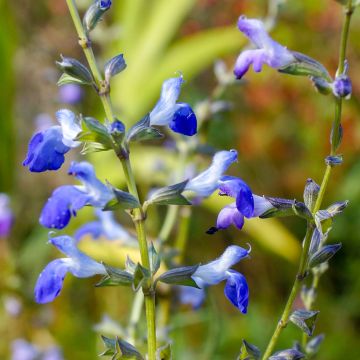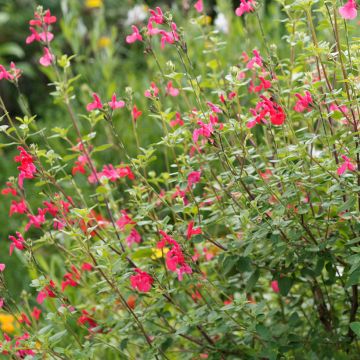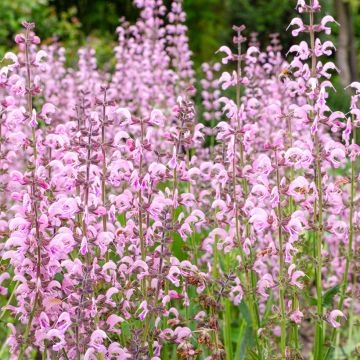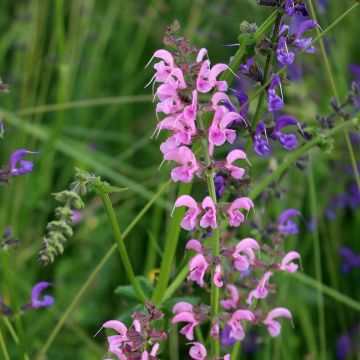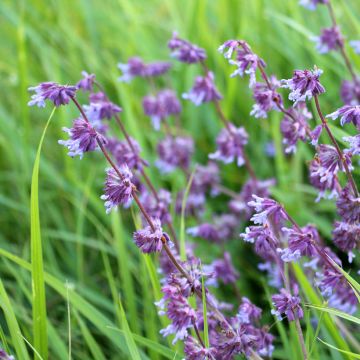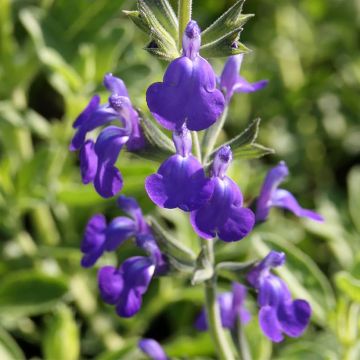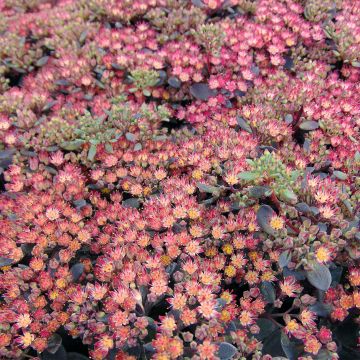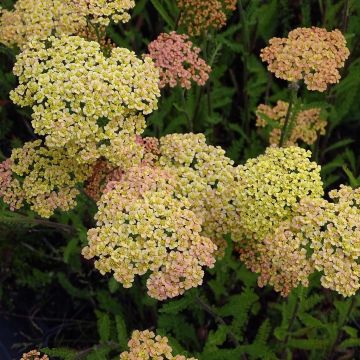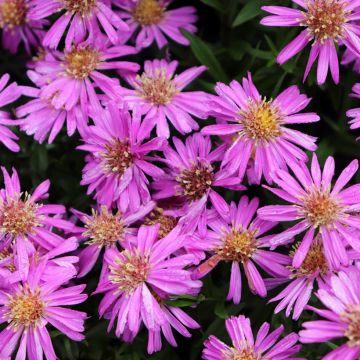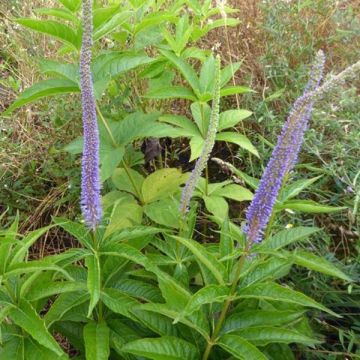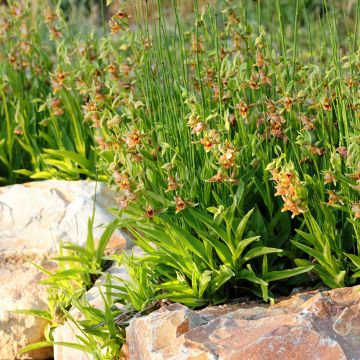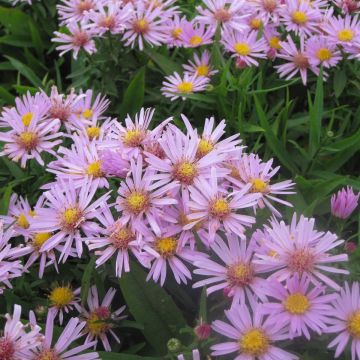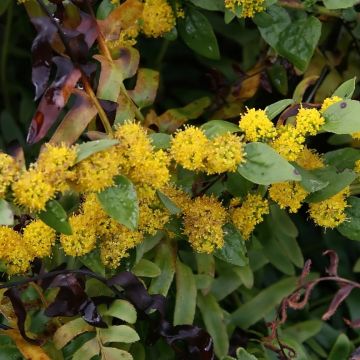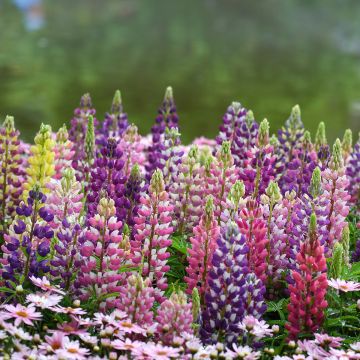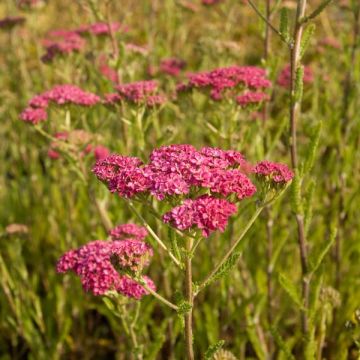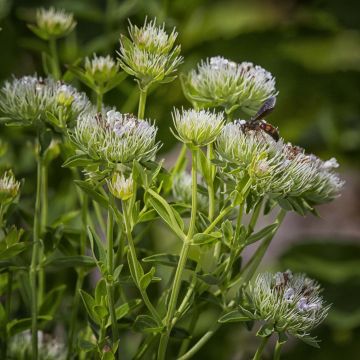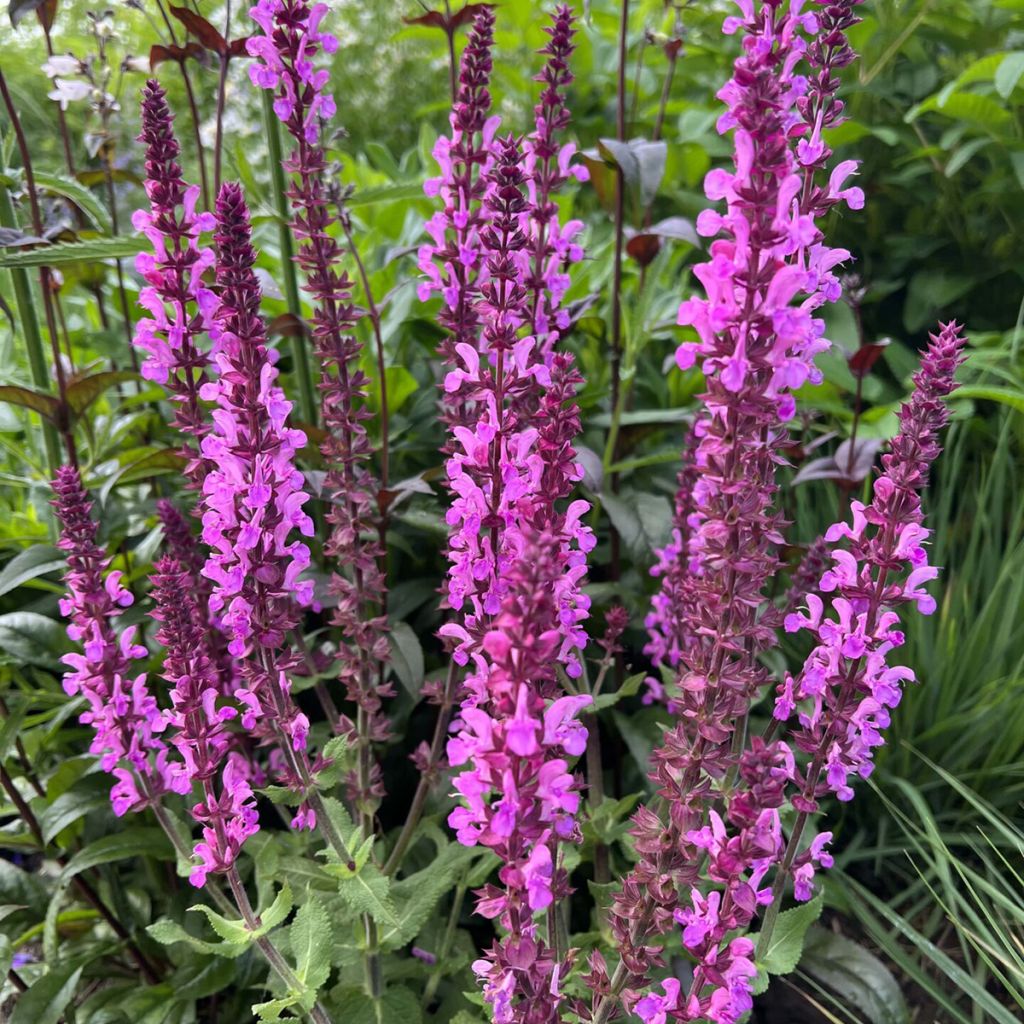

Salvia x sylvestris Lyrical Katsjing
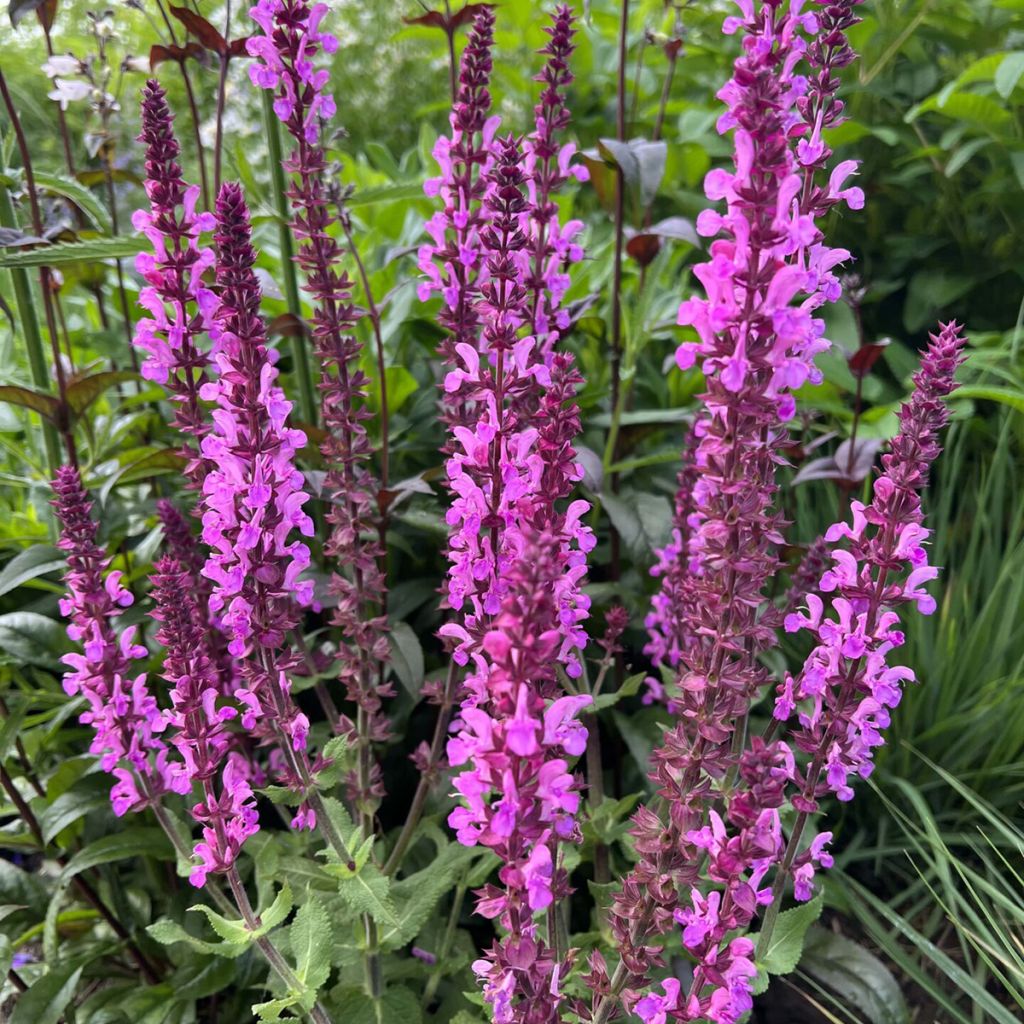

Salvia x sylvestris Lyrical Katsjing
Salvia x sylvestris Lyrical Katsjing
Salvia x sylvestris Katsjing
Woodland Sage, Balkan Clary
This item cannot be shipped to the selected country
Delivery charge from €5.90
More information
Schedule delivery date,
and select date in basket
This plant carries a 12 months recovery warranty
More information
We guarantee the quality of our plants for a full growing cycle, and will replace at our expense any plant that fails to recover under normal climatic and planting conditions.
From €5.90 for pickup delivery and €6.90 for home delivery
Express home delivery from €8.90.
Does this plant fit my garden?
Set up your Plantfit profile →
Description
Salvia nemorosa 'Lyrical Katsjing' or Salvia x sylvestris 'Katsjing' is a variety of compact bush sage with long and abundant intense pink flowering. It forms a small, well-branched bushy clump, has aromatic grey-green foliage, and blooms densely from early to late summer. Not demanding in terms of water, tolerant of clayey and limestone soils, it is a perennial as generous as it is easy to grow. Excellent in borders or containers, charming in a planter. It is highly attractive to pollinating insects.
Salvia nemorosa 'Lyrical Katsjing' is an American horticultural selection from the 'Lyrical' series. It is a perennial of the mint family or labiates. Its wild ancestor, wood sage, is a native species of Central Europe and Western Asia. 'Lyrical Katsjing' forms a small, bushy clump of leafy stems, reaching a height of 50 to 60cm (20 to 24in) when in bloom, with a spread of approximately 50cm (20in). This perennial develops from a prostrate rosette of rough, grey-green, ovate leaves with toothed edges that persist throughout winter. Flowering begins in May-June, followed by new waves of flowers between July and September if the faded flower spikes are pruned. The flowers are produced in terminal clusters composed of numerous small flowers (0.5 to 1cm) of intense and vibrant pink, surrounded by burgundy to purple bracts. This mix of colours is very refreshing. The beautiful compact spikes with nectar-rich flowers delight butterflies. The base of the stems is often reddish.
This 'Katsjing' wood sage is resistant to wind, cold, heat, and adapts to a wide range of soils. It looks superb when planted alongside blue, violet, or white salvias in a border. It also pairs well with ground-cover roses ('Bees Paradise Pink', 'Opalia', 'Nozomi') or with grey foliage. In a small bed, it complements well, for example, Physocarpus opulifolius Lady in Red' with its beautiful purple foliage. It also pairs nicely with pink-flowering plants such as the rose vervain 'Rosea', the shrubby mallow 'Barnsley', or Penstemon 'Evelyn'. It also works perfectly in the composition of beds and borders alongside the blue flowers of Perovskia or perennial Geraniums.
With over 900 species of annuals, perennials, and softwood shrubs distributed all over the globe, except in very cold regions and tropical forests, the genus Salvia is the most diverse in the mint family. The name Salvia, which dates back to Roman times, derives from the Latin salvus, meaning "healthy," alluding to the medicinal properties of common sage.
Report an error about the product description
Flowering
Foliage
Plant habit
Botanical data
Salvia
x sylvestris
Katsjing
Lamiaceae
Woodland Sage, Balkan Clary
Cultivar or hybrid
Other Salvia - Sage
Planting and care
Plant Lyrical 'Katsjing' sage in ordinary soil, even clay-limestone, but especially well-prepared, loosened and relatively draining. This plant tolerates some drought in summer, which can, however, harm its flowering. It does not appreciate soils that are both heavy and waterlogged in winter, which can affect its hardiness. You will plant it in a sunny or semi-shady location. It is an easy plant, very floriferous. In spring, give it fertilizer and in April, cut all the branches in half. Trim the faded floral stems to stimulate and prolong flowering. To preserve the vitality of the sage, it is good to divide the plant after 3 years. Plant the new plants in well-worked soil: to improve soil that is slightly too poor or too compact, mix in a little horticultural compost.
Planting period
Intended location
Care
This item has not been reviewed yet - be the first to leave a review about it.
Summer flowering perennials
Haven't found what you were looking for?
Hardiness is the lowest winter temperature a plant can endure without suffering serious damage or even dying. However, hardiness is affected by location (a sheltered area, such as a patio), protection (winter cover) and soil type (hardiness is improved by well-drained soil).

Photo Sharing Terms & Conditions
In order to encourage gardeners to interact and share their experiences, Promesse de fleurs offers various media enabling content to be uploaded onto its Site - in particular via the ‘Photo sharing’ module.
The User agrees to refrain from:
- Posting any content that is illegal, prejudicial, insulting, racist, inciteful to hatred, revisionist, contrary to public decency, that infringes on privacy or on the privacy rights of third parties, in particular the publicity rights of persons and goods, intellectual property rights, or the right to privacy.
- Submitting content on behalf of a third party;
- Impersonate the identity of a third party and/or publish any personal information about a third party;
In general, the User undertakes to refrain from any unethical behaviour.
All Content (in particular text, comments, files, images, photos, videos, creative works, etc.), which may be subject to property or intellectual property rights, image or other private rights, shall remain the property of the User, subject to the limited rights granted by the terms of the licence granted by Promesse de fleurs as stated below. Users are at liberty to publish or not to publish such Content on the Site, notably via the ‘Photo Sharing’ facility, and accept that this Content shall be made public and freely accessible, notably on the Internet.
Users further acknowledge, undertake to have ,and guarantee that they hold all necessary rights and permissions to publish such material on the Site, in particular with regard to the legislation in force pertaining to any privacy, property, intellectual property, image, or contractual rights, or rights of any other nature. By publishing such Content on the Site, Users acknowledge accepting full liability as publishers of the Content within the meaning of the law, and grant Promesse de fleurs, free of charge, an inclusive, worldwide licence for the said Content for the entire duration of its publication, including all reproduction, representation, up/downloading, displaying, performing, transmission, and storage rights.
Users also grant permission for their name to be linked to the Content and accept that this link may not always be made available.
By engaging in posting material, Users consent to their Content becoming automatically accessible on the Internet, in particular on other sites and/or blogs and/or web pages of the Promesse de fleurs site, including in particular social pages and the Promesse de fleurs catalogue.
Users may secure the removal of entrusted content free of charge by issuing a simple request via our contact form.
The flowering period indicated on our website applies to countries and regions located in USDA zone 8 (France, the United Kingdom, Ireland, the Netherlands, etc.)
It will vary according to where you live:
- In zones 9 to 10 (Italy, Spain, Greece, etc.), flowering will occur about 2 to 4 weeks earlier.
- In zones 6 to 7 (Germany, Poland, Slovenia, and lower mountainous regions), flowering will be delayed by 2 to 3 weeks.
- In zone 5 (Central Europe, Scandinavia), blooming will be delayed by 3 to 5 weeks.
In temperate climates, pruning of spring-flowering shrubs (forsythia, spireas, etc.) should be done just after flowering.
Pruning of summer-flowering shrubs (Indian Lilac, Perovskia, etc.) can be done in winter or spring.
In cold regions as well as with frost-sensitive plants, avoid pruning too early when severe frosts may still occur.
The planting period indicated on our website applies to countries and regions located in USDA zone 8 (France, United Kingdom, Ireland, Netherlands).
It will vary according to where you live:
- In Mediterranean zones (Marseille, Madrid, Milan, etc.), autumn and winter are the best planting periods.
- In continental zones (Strasbourg, Munich, Vienna, etc.), delay planting by 2 to 3 weeks in spring and bring it forward by 2 to 4 weeks in autumn.
- In mountainous regions (the Alps, Pyrenees, Carpathians, etc.), it is best to plant in late spring (May-June) or late summer (August-September).
The harvesting period indicated on our website applies to countries and regions in USDA zone 8 (France, England, Ireland, the Netherlands).
In colder areas (Scandinavia, Poland, Austria...) fruit and vegetable harvests are likely to be delayed by 3-4 weeks.
In warmer areas (Italy, Spain, Greece, etc.), harvesting will probably take place earlier, depending on weather conditions.
The sowing periods indicated on our website apply to countries and regions within USDA Zone 8 (France, UK, Ireland, Netherlands).
In colder areas (Scandinavia, Poland, Austria...), delay any outdoor sowing by 3-4 weeks, or sow under glass.
In warmer climes (Italy, Spain, Greece, etc.), bring outdoor sowing forward by a few weeks.

































